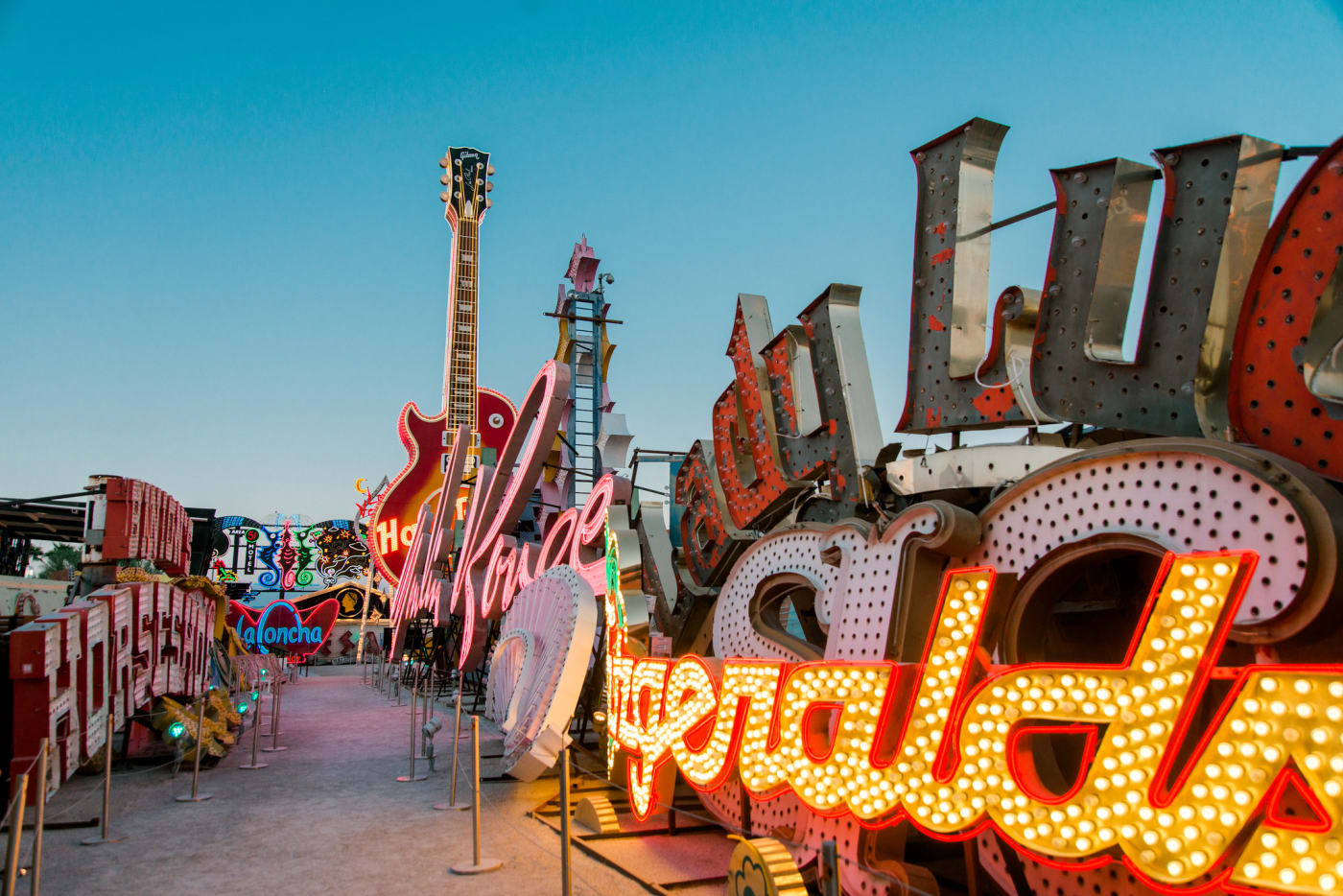
Another example of retired signs at the Young Electric Sign Company (YESCO) boneyard.
YESCO Photograph Collection, The Neon Museum, late 1990s.
When you think of Las Vegas, you think of light. Towering signs. Dazzling marquees. Neon bending around every corner like liquid fire. That glow? A lot of it can be credited to YESCO.
WHO IS YESCO?
YESCO, short for Young Electric Sign Company, was founded in 1920 by Thomas Young in Ogden, Utah. Young was a 25-year-old sign painter whose vision was to use electricity to transform signage into something unforgettable. What started as a humble operation designing lighted storefronts quickly grew as technology advanced and demand skyrocketed.
By the 1930s, YESCO saw the future unfolding 350 miles south in Las Vegas. At the time, Vegas was still more of a desert town than an entertainment capital. But YESCO understood the potential. Their signs would attract visitors from all over the country.
DESIGNING THE LAS VEGAS LOOK
Through their iconic work, YESCO helped define the look and feel of Las Vegas. Their style blended bright neon tubing with intricate metalwork, bold typography, kinetic elements, and animated lights. Every letter, arrow, and sparkle seduced the eye.
Some of their most legendary creations became synonymous with the city itself. Here are a few examples:
- YESCO built Vegas Vic, the 40-foot-tall cowboy who waves and winks over Fremont Street, in 1951. With his animatronic arm and voicebox that once said “Howdy partner!”, Vic became an icon of Western hospitality.
- The glowing, star-topped Stardust sign, designed to resemble atomic particles in mid-collision, was YESCO’s response to the Atomic Age, lighting up the Strip in 1958.
- The eye-catching Hard Rock Café guitar, with custom lighting programmed to mimic real guitar strings in motion, was a YESCO creation
MASTERS OF NEON & INNOVATION
YESCO built its reputation on neon, but the company never stood still. As lighting technology evolved, so did YESCO’s approach. They moved from glass tubing to incandescent bulbs, then to LEDs, full-color displays, and programmable digital signage. Today, they install 100-foot-high video walls that cover the sides of casinos and arenas in Las Vegas.
But neon never went out of style. YESCO still restores vintage neon signs, and its technicians are some of the last artisans trained in classic tube-bending and hand-lettering techniques. It’s that respect for history, combined with an eye toward the future, that keeps YESCO relevant in the 21st century.
YESCO AT THE NEON MUSEUM
Many of the stories and signs you can find at The Neon Museum come from YESCO’s archive of work. Our collection features several original YESCO signs, each with its own voice and history:
- The Moulin Rouge sign, with its sweeping cursive and pink neon, represents more than a nightclub. It was the first racially integrated casino in Las Vegas and a symbol of progress during the Civil Rights era.
- The Silver Slipper, once perched on the Strip and owned by reclusive billionaire Howard Hughes, was actually shut off by Hughes himself because the rotating slipper faced his penthouse and made him paranoid. It now proudly lives on the Las Vegas Boulevard Scenic Byway Project.
- The Yucca Motel, a roadside staple along Las Vegas Boulevard, features a radiant starburst and arrow design that screams mid-century modern Americana.
- Binion’s Horseshoe, with its bright lights and blocky, muscular lettering, speaks to the bold spirit of downtown’s gambling scene.
- The Bow & Arrow Motel, a playful and unmistakably retro design that combines neon tubing with stylized imagery that reflects both the times and the themes of midcentury travel culture. The Bow & Arrow Motel sign is also displayed on the Las Vegas Boulevard Scenic Byway Project.
- The iconic Jerry’s Nugget sign, still operating in North Las Vegas, lives on thanks to YESCO’s work and the community’s love for this local institution.
Each of these signs tells a story of Las Vegas history. And YESCO’s role in designing, building, or maintaining them connects past and present in glowing color.
LIGHTING THE WAY FORWARD
YESCO is still family-owned, still headquartered in Utah, and still designing some of the most recognizable signage in the world. Their work now lights up everything from Universal City Walk to NFL stadiums, but Las Vegas remains one of their most beloved projects.
Las Vegas has always been about reinvention, but it never forgets its past. That’s why YESCO’s work matters so much to the area. The Neon Museum is proud to partner with YESCO on restoration projects that keep historic signs alive, whether they’re lighting up the sky or resting in the Boneyard.

Hidden Signs in Las Vegas Neighborhoods
- Downtown Las Vegas
- Las Vegas History

The Neon Museum Welcomes Melisa McChesney as Director of Lifelong Learning
- Media Releases

How Many of the Signs Light Up?
- FAQs
- Our Spaces
